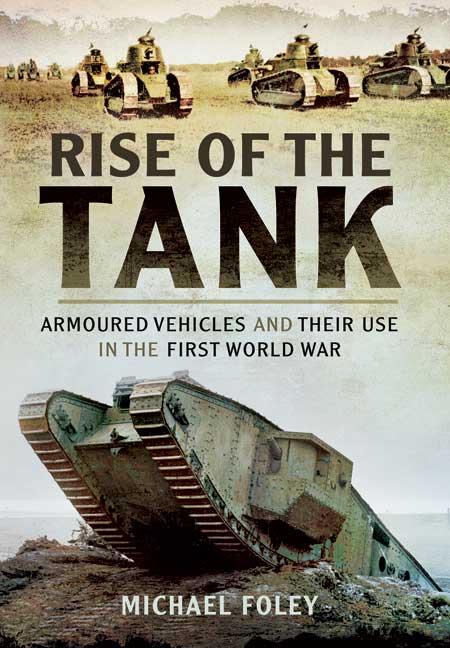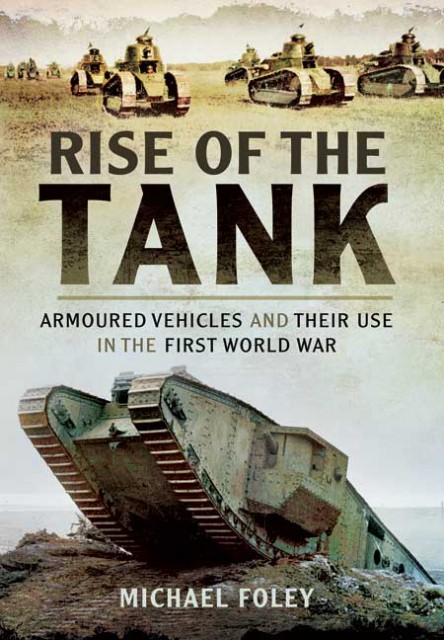This is a book about tanks in the Great War and the author highlights the need for the tank in that conflict, presenting his opinion and argument in the Introduction,“It seems as if those in command of British forces were prepared to send endless thousands of men across no man’s land in the face of German machine guns, perhaps this was how wars had always been fought.” The book, using previously published material, unpublished sources from the Imperial War Museum, The National Archive and the National Army Museum, periodicals, magazines and newspapers, is divided into four chapters. The first chapter “The Idea of a Land Ship”, deals with the concept of the tank and rightly informs the reader that the notion of an armoured fighting vehicle was not new nor was it a solely British idea. For instance the Germans had been experimenting with armoured fighting vehicles in the years before the Great War.
The second chapter “Development of the Tank”, describes the struggle to get the tank designed and built in Britain, France, and Germany and latterly in America. Chapter four, “The Tank in Action”, tells the reader about tanks in action during the war and discusses the different types and marks of tanks in use in various different action. The final chapter, “The Men and the Tanks” is devoted to the British tank crews. Throughout the book Foley reminds the reader that Churchill was the greatest exponent of the British invention and that Ludendorff fixated upon the tank as one of the main reasons for Allied success. Well, I agree that Churchill was keen on the tank but then so were many others on the Allied side. Perhaps more could have been made of the fact that Haig, while recognising their shortcomings, was an enthusiastic supporter of the tank as he was of many innovations during the Great War. As for First Quartermaster General Ludendorff, I should say that he would have blamed the defeat of Germany on his own Grandmother rather than take a large part of that responsibility upon himself. The reason for the late production of a German tank is not hard to know.
Ludendorff understood that German industrial capacity was stretched to the limit coping with the munitions demands of the army. Therefore, the Germans initially opted for tank destruction rather than production, using the tools already available to them and in my view they became very good at anti-tank warfare. Anti-tank rifles, field gun crews engaging targets over open sights, flamethrower teams and specialist snipers often worked together to defeat tanks. Foley says that “how much influence the tank had on the outcome of the war is unclear.” Yes, to my mind the tank was part of the All Arms victory of 1918, not the reason for that victory. There are a number of photographs and captions in the book, some of which are very interesting indeed. A few, or at least their captions, are odd. The group of girls in flying helmets referred to as “munitions workers” are in front of an aircraft.
Two identical photographs appear with different captions in different parts of the book and a photograph of a French tank, with rows of weapons and a railway carriage has the caption, “A French card with the title Courd’Honour (Court of Honour). It seems to be some kind of memorial to the war with guns and a Renault tank.” Yes, this would be Courd’Honneur. It is a well-known and well circulated photograph of Foch’s French railway carriage, the one in which the Armistice was signed, in the yard of the Hôtel des Invalides where it was on display for six years in the 1920s. “Some kind of memorial?” I should think so.
Well, here we have it; a book about tanks with a very British slant. Foley makes some good points, presents some interesting history and some genuinely interesting photographs. This book is not entirely to my taste, nonetheless some people might like it, and some may not.
Reviewed by Dr Wayne Osborne for War History Online and you can buy the book here Pen &Sword
RISE OF THE TANK
Armoured Vehicles And Their Use In The First World War By Michael Foley.
Pen & Sword ISBN 978 1 78346 393 0

